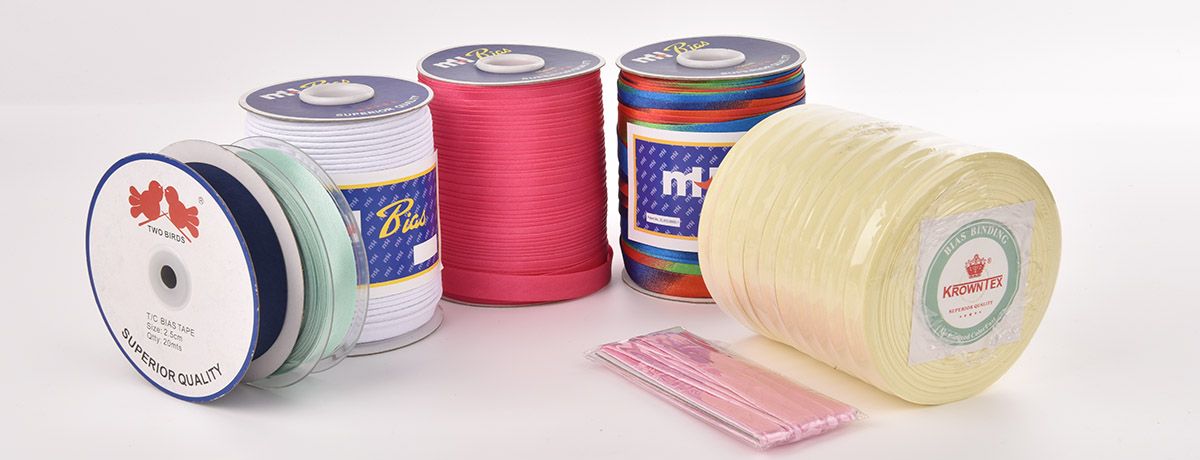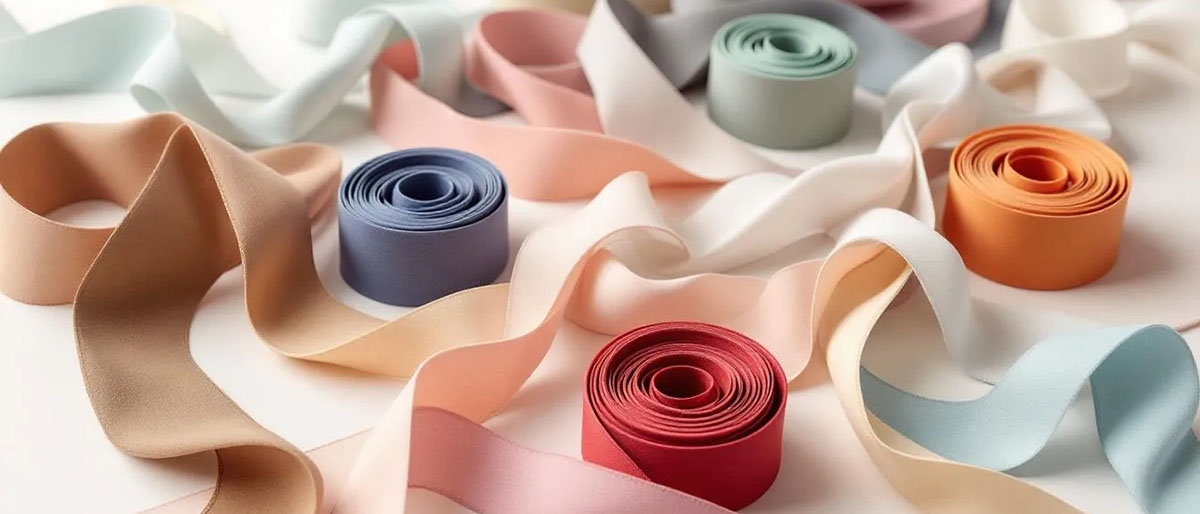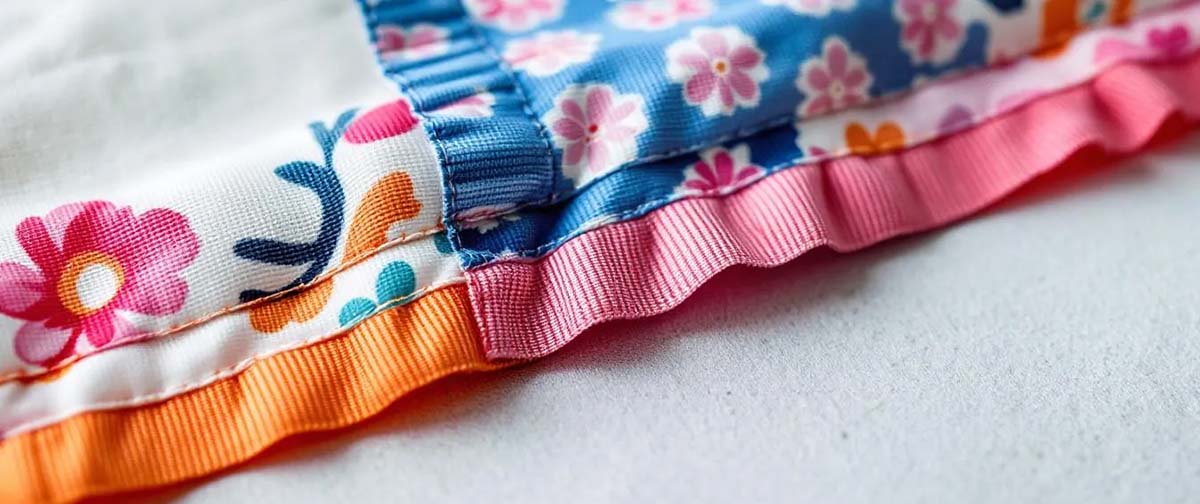Bulk Bias Binding: Best Options for Your Sewing Projects

Are you looking for efficient ways to finish your sewing projects? Bulk bias binding offers a flexible and adaptable solution. Cut at a 45° angle, this binding conforms to curves and edges seamlessly. Whether for quilts, garments, or other textiles, bulk bias binding ensures cleaner, wrinkle-free finishes, making it an essential component for large-scale projects.
Key Takeaways
-
Bulk bias binding, cut at a 45° angle, offers flexibility and adaptability for finishing the edges of various sewing projects, while minimizing seams for cleaner edges.
-
Available in multiple types such as single fold, double fold, piping, and printed bias binding, each serves specific applications ranging from functional to decorative uses.
-
Purchasing bias binding in bulk is cost-effective and ensures a consistent supply, which is essential for uniformity in large or multiple sewing projects.
Understanding Bulk Bias Binding

Bulk bias binding is created by cut fabric strips at a 45° angle, which allows the binding to stretch and conform to curves in sewing projects. This unique cut technique results in a flexible and adaptable binding that can seamlessly finish the edges of quilts, garments, and more. The adaptability of bias binding makes it a preferred choice for various applications, ensuring smooth, wrinkle-free edges that hug the contours of your project.
The production process of bulk bias binding is designed to minimize seams, resulting in cleaner edges and better alignment, especially when working with patterned fabric. This efficiency is particularly beneficial for large-scale projects or when uniformity is crucial. Whether you’re a garment factory, textile workshop, or a distributor of sewing materials, having access to high-quality bulk bias binding can significantly enhance the quality and consistency of your products.
Moreover, reputable suppliers like MH offer a diverse range of bulk bias bindings, catering to various industries and ensuring a reliable supply of this essential sewing component.
Types of Bias Binding Available in Bulk
Bias binding comes in various types, each tailored for specific applications and preferences. One of the most common types is single fold bias tape, which consists of a single layer of fabric folded in half. This type is pre folded, lightweight and easy to work with, making it suitable for projects where a minimalistic finish is desired.
Double fold bias tape, on the other hand, offers more coverage and durability. It is created by folding a strip of fabric in half and then folding both edges towards the center, resulting in a double-layered binding. This type is ideal for projects that require a robust finish, such as heavy garments or items that will undergo frequent washing.
For those seeking decorative finishes, piping bias binding is an excellent choice. This type features a cord enclosed in fabric, providing a decorative edge for projects like upholstery and bags. Printed bias tape is another option that adds visual interest with various patterns and designs, perfect for adding a unique touch to your sewing crafts decorations projects. The thread used in these applications can enhance the overall look and durability.
Lastly, satin bias binding made from smooth, shiny polyester offers an elegant finish for garments, while cotton bias binding is versatile and breathable, suitable for a wide range of sewing applications. With these diverse options, you can find the perfect type of bias binding to suit your specific project needs.
Materials Used in Bias Binding
The material used in bias binding plays a crucial role in determining its suitability and durability for various projects. 100% cotton bias binding is highly valued for its natural qualities and is extensively used across different industries, including childcare. Cotton bias binding is breathable and comfortable, making it an excellent choice for garments and other items that come into direct contact with the skin.
Choosing the right material for your bias binding ensures it complements the fabric of your project. For instance, cotton binding pairs well with cotton fabrics, creating a cohesive look. Satin bias binding, made from pure polyester, offers a luxurious finish, perfect for elegant garments, and is available in various colors to match any design.
Eco-friendly materials are also available, providing sustainable options for environmentally conscious consumers. Whether you prefer:
-
Cotton
-
Polyester
-
A poly-cotton blend MH offers a variety of materials to meet your specific needs. Additionally, MH supports customization in:
-
Material
-
Width
-
Color
-
Packaging ensuring you get exactly what you need for your projects.
Popular Widths and Lengths for Bulk Bias Binding
Bias binding comes in various widths and lengths to accommodate different sewing projects. Common widths for bulk bias binding range from 9mm to 50mm, allowing you to choose the perfect size for your specific needs. Whether you’re working on delicate garments or large quilts, there is a width that will suit your project.
Lengths of bulk bias binding are typically available in increments of 50 meters, 100 meters, and 200 meters, catering to different project requirements. This flexibility ensures that you can purchase the right amount of bias binding for your projects, reducing waste and ensuring you have enough to complete your work.
Customization options are also available, allowing you to tailor the widths and lengths to suit specific needs. MH provides bias bindings in widths from 9mm to 50mm and offers bulk rolls in lengths of 50m, 100m, 200m, or customized yardage, ensuring you get the perfect fit for your projects.
Color Options and Customization
Color options and customization play a significant role in the appeal and functionality of bias binding. Key points include:
-
A wide range of colors can be created to match specific Pantone colors.
-
This allows for precise customization.
-
Ensures your project has the perfect finishing touch.
-
Particularly beneficial for projects requiring specific color schemes.
-
Useful for matching existing fabrics.
Bias binding orders can be customized with unique patterns or textures, enhancing the finished product’s aesthetic appeal for customers. Bulk purchases offer more options for colors and patterns, fostering great creativity and allowing for a personal touch in your projects. This item can truly elevate your designs on this page. Reviews can provide valuable insights into the quality of bias binding. Share your experiences with others to inspire creativity.
MH offers over 300 standard shades of bias bindings and can color-check match to Pantone or cloth samples, providing a wide variety of options to meet your needs. With OEM/ODM customization available in material, width, color, and packaging, MH ensures you get exactly what you need for your sewing projects.
Applications of Bulk Bias Binding

Bulk bias binding is incredibly versatile and can be used in a wide range of applications. Making bias binding in bulk is particularly beneficial for projects requiring large quantities, such as quilts or matching garments, ensuring you have a consistent supply.
MH’s bias bindings are applicable in garment and uniform manufacturing, providing a clean and professional finish to raw edges and seams. They are also suitable for bedding, curtain, and home textile production, adding a polished look to these household items.
Additionally, bias bindings are ideal for quilting, handicrafts, and DIY sewing projects, offering both functional and decorative benefits. Whether you’re creating a custom quilt or personalizing home décor items, bulk bias binding provides the flexibility and consistency needed to achieve professional results.
Benefits of Buying Bias Binding in Bulk
Purchasing bias binding in bulk offers numerous benefits, particularly for those working on large or multiple projects. One of the primary advantages is the reduced cost per unit, making it more economical for extensive sewing endeavors. Group discounts and wholesale accounts further enhance the cost-effectiveness of bulk purchases.
A consistent supply of bias binding is crucial for uniformity in projects and other things. Buying in bulk ensures you have enough material, reducing the risk of running out mid-project. Reliable on-time delivery from verified manufacturers means you can trust your order will arrive promptly, keeping your projects on schedule.
A substantial stock of bias binding enhances efficiency, allowing for quicker assembly and reducing wait times between projects. Additionally, buying in larger quantities minimizes waste by reducing leftover scraps. MH offers factory-direct bulk supply with stable quality and competitive prices, making it a practical choice for frequent sewists.
How to Choose the Right Bias Binding for Your Projects
Choosing the right bias binding for your projects involves considering various factors like width, type, and application. Common bias binding widths include:
-
12 mm
-
18 mm
-
25 mm
-
30 mm These widths cater to a variety of sewing needs. The most frequently purchased widths, 18 mm and 30 mm, offer versatility for both clothing and household items.
Bias binding serves both decorative and functional purposes, including:
-
Finishing raw edges
-
Adding decorative elements
-
Creating functional components like button loops and ties for garments
-
Providing durability and an attractive finish to quilt edges
-
Creating unique gifts such as pot holders and baby bibs
-
Extending hemlines without needing additional fabric
Using a bias maker can simplify the process of folding strips of bias binding evenly, ensuring a professional finish. By considering your project’s specific needs and the type of fabric you’re working with, you can find the perfect bias binding to enhance your sewing creations.
Tips for Sewing with Bias Binding
Sewing with bias binding can be a breeze with the right techniques and tips. To apply bias binding effectively:
-
Align and pin the right side of the bias strip to the wrong side of the fabric.
-
Stitch along the first crease for a clean finish.
-
For a neat finish on the ends, extend the binding 1/4 inch beyond the edge of the fabric.
-
Trim the corner seam allowance at a diagonal.
Joining two ends of a continuous bias strip can be done by folding one end under and overlapping it with the other, ensuring both raw edges align for a seamless finish. When preparing bias binding for curves, steam-press it into the desired shape to help it roll and conform more easily during application.
Tips for working with bias binding:
-
For thick fabrics, stitch the initial seam of the bias binding narrower than the first crease to allow enough fabric to wrap around the thickness comfortably.
-
Use spray starch on bias binding before cutting to add stability, making it easier to work with on curves.
-
When pressing bias binding, lift and place the iron instead of sliding it to avoid unnecessary stretching.
Ensuring that seams in bias binding strips are pressed open reduces bulk and enhances flexibility, resulting in long-lasting and professional results. For visible projects, opt for double-fold bias binding, while single-fold is better suited for edges where the binding won’t be seen. MH’s bias bindings feature even folding and smooth edges, making them perfect for trimming, binding seams, and decorative use.
Care and Maintenance of Bias Binding
Proper care and maintenance of bias binding ensure its longevity and effectiveness. Always handle bias binding with care to prevent stretching or distortion during application. Washing bias binding should be done in cold water on a gentle cycle to preserve its integrity, especially if it has been used in quilts.
To maintain the quality of bias binding:
-
Use a mild detergent during the washing process.
-
Avoid letting wet items sit in the washing machine for too long, as this can damage the binding.
-
Dry bias binding at a low temperature to prevent potential damage and keep it in good condition.
Pre-washing fabrics before making items with bias binding can prevent potential dye bleeding during washing, ensuring the colors remain vibrant and the binding stays intact. By following these care tips, you can ensure that your bias binding remains effective and maintains its quality over time.
Summary
Summarizing the key points, bulk bias binding is an essential tool for any serious sewist. Its flexibility, variety of types, and wide range of materials make it a versatile choice for numerous projects. Whether you need single fold, double fold, or a decorative piping bias, understanding the options available can significantly enhance your sewing projects. Additionally, the availability of custom widths and lengths ensures you can always find the perfect fit for your specific needs.
Purchasing bias binding in bulk not only provides economic benefits but also ensures a consistent supply, enhancing efficiency and reducing waste. By selecting the right bias binding and following proper care and sewing tips, you can achieve professional and durable finishes on all your sewing creations. Embrace the convenience and versatility of bulk bias binding to elevate your sewing projects to a new level of excellence.
Frequently Asked Questions
What is bulk bias binding, and why is it used?
Bulk bias binding is fabric cut on the bias, which allows it to stretch and effectively conform to curves, making it ideal for finishing edges and enhancing the aesthetic appeal of sewing projects.
What types of bias binding are available in bulk?
Various types of bias binding available in bulk include single fold, double fold, piping, printed, satin, and cotton bias tape. Each type serves different purposes for sewing and crafting projects.
What materials are commonly used for bias binding?
Bias binding commonly uses 100% cotton, polyester, and poly-cotton blends, each providing distinct qualities for various uses.
How do I choose the right width and type of bias binding for my project?
To choose the right width and type of bias binding, evaluate your project's fabric type and binding function, with 18 mm and 30 mm being among the most versatile options. Select a width that complements your fabric and meets the specific needs of your project for optimal results.
What are the benefits of buying bias binding in bulk?
Purchasing bias binding in bulk is cost-effective, providing savings over individual purchases, while also guaranteeing a consistent supply for ongoing projects. This approach enhances efficiency and minimizes waste, making it ideal for large or frequent use.


